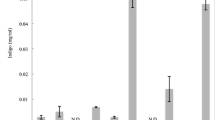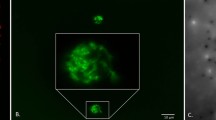Abstract
Two different cultivation-independent approaches were applied to isolate genes for naphthalene dioxygenase (NDO) from oil-contaminated soil in Japan. One approach was the construction of a broad-host-range cosmid-based metagenomic DNA library, and the other was the so-called exogenous plasmid isolation technique. Our screening of NDO genes in both approaches was based on the functional complementation of Pseudomonas putida strains which contained Tn4655K, a transposon carrying the entire set of naphthalene-catabolic (nah) genes but lacking the NDO-encoding gene. We obtained in the former approach a cosmid clone (pSLX928-6) that carried an nah upper pathway operon for conversion of naphthalene to salicylate, and this operon showed a significantly high level of similarity to the corresponding operon on an IncP-9 naphthalene-catabolic plasmid, pDTG1. In the latter approach, the microbial fraction from the soil was mated with a plasmid-free P. putida strain containing a chromosomal copy of Tn4655K, and transconjugants were obtained that received either a 200- or 80-kb plasmid containing all the nah genes for the complete degradation of naphthalene. Subsequent analysis revealed that (1) both plasmids belong to the IncP-9 incompatibility group; (2) their nah upper pathway operons are significantly similar, but not completely identical, to those of pDTG1 and pSLX928-6; and (3) these plasmids carried genes for the salicylate metabolism by the meta-cleavage pathway.


Similar content being viewed by others
References
Amann RI, Ludwig W, Schleifer KH (1995) Phylogenetic identification and in situ detection of individual microbial cells without cultivation. Microbiol Rev 59:143–169
Assinder SJ, Williams PA (1990) The TOL plasmids: determinants of the catabolism of toluene and the xylenes. Adv Microb Physiol 31:1–69
Bale MJ, Fry JC, Day MJ (1987) Plasmid transfer between strains of Pseudomonas aeruginosa on membrane filters attached to river stones. J Gen Microbiol 133:3099–3107
Dennis JJ, Zylstra GJ (1998) Plasposons: modular self-cloning minitransposon derivatives for rapid genetic analysis of gram-negative bacterial genomes. Appl Environ Microbiol 64:2710–2715
Dennis JJ, Zylstra GJ (2004) Complete sequence and genetic organization of pDTG1, the 83 kilobase naphthalene degradation plasmid from Pseudomonas putida strain NCIB 9816-4. J Mol Biol 341:753–768
Dos Santos VA, Heim S, Moore ER, Stratz M, Timmis KN (2004) Insights into the genomic basis of niche specificity of Pseudomonas putida KT2440. Environ Microbiol 6:1264–1286
Droge M, Pühler A, Selbitschka W (2000) Phenotypic and molecular characterization of conjugative antibiotic resistance plasmids isolated from bacterial communities of activated sludge. Mol Gen Genet 263:471–482
Dunn NW, Gunsalus IC (1973) Transmissible plasmid coding early enzymes of naphthalene oxidation in Pseudomonas putida. J Bacteriol 114:974–979
Eaton RW (1994) Organization and evolution of naphthalene catabolic pathways: sequence of the DNA encoding 2-hydroxychromene-2-carboxylate isomerase and trans-o-hydroxybenzylidenepyruvate hydratase-aldolase from the NAH7 plasmid. J Bacteriol 176:7757–7762
Eaton RW, Chapman PJ (1992) Bacterial metabolism of naphthalene: construction and use of recombinant bacteria to study ring cleavage of 1,2-dihydroxynaphthalene and subsequent reactions. J Bacteriol 174:7542–7554
El-Fantroussi S, Verstraete W, Top EM (2000) Enrichment and molecular characterization of a bacterial culture that degrades methoxy-methyl urea herbicides and their aniline derivatives. Appl Environ Microbiol 66:5110–5115
Gabor EM, de Vries EJ, Janssen DB (2003) Efficient recovery of environmental DNA for expression cloning by indirect extraction methods. FEMS Microbiol Ecol 44:153–163
Gabor EM, de Vries EJ, Janssen DB (2004) Construction, characterization, and use of small-insert gene banks of DNA isolated from soil and enrichment cultures for the recovery of novel amidases. Environ Microbiol 6:948–958
Gotz A, Pukall R, Smit E, Tietze E, Prager R, Tschape H, van Elsas JD, Smalla K (1996) Detection and characterization of broad-host-range plasmids in environmental bacteria by PCR. Appl Environ Microbiol 62:2621–2628
Greated A, Lambertsen L, Williams PA, Thomas CM (2002) Complete sequence of the IncP-9 TOL plasmid pWW0 from Pseudomonas putida. Environ Microbiol 4:856–871
Heeb S, Itoh Y, Nishijyo T, Schnider U, Keel C, Wade J, Walsh U, O’Gara F, Haas D (2000) Small, stable shuttle vectors based on the minimal pVS1 replicon for use in gram-negative, plant-associated bacteria. Mol Plant Microbe Interact 13:232–237
Hoang TT, Karkhoff-Schweizer RR, Kutchma AJ, Schweizer HP (1998) A broad-host-range Flp-FRT recombination system for site-specific excision of chromosomally-located DNA sequences: application for isolation of unmarked Pseudomonas aeruginosa mutants. Gene 212:77–86
Hohnstock AM, Stuart-Keil KG, Kull EE, Madsen EL (2000) Naphthalene and donor cell density influence field conjugation of naphthalene catabolism plasmids. Appl Environ Microbiol 66:3088–3092
Izmalkova TY, Mavrodi DV, Sokolov SL, Kosheleva IA, Smalla K, Thomas CM, Boronin AM (2006) Molecular classification of IncP-9 naphthalene degradation plasmids. Plasmid 56:1–10
Kado CI, Liu ST (1981) Rapid procedure for detection and isolation of large and small plasmids. J Bacteriol 145:1365–1373
Kauppi B, Lee K, Carredano E, Parales RE, Gibson DT, Eklund H, Ramaswamy S (1998) Structure of an aromatic-ring-hydroxylating dioxygenase-naphthalene 1,2-dioxygenase. Structure 6:571–586
Kimbara K, Hashimoto T, Fukuda M, Koana T, Takagi M, Oishi M, Yano K (1989) Cloning and sequencing of two tandem genes involved in degradation of 2,3-dihydroxybiphenyl to benzoic acid in the polychlorinated biphenyl-degrading soil bacterium Pseudomonas sp. strain KKS102. J Bacteriol 171:2740–2747
Kiyohara H, Torigoe S, Kaida N, Asaki T, Iida T, Hayashi H, Takizawa N (1994) Cloning and characterization of a chromosomal gene cluster, pah, that encodes the upper pathway for phenanthrene and naphthalene utilization by Pseudomonas putida OUS82. J Bacteriol 176:2439–2443
Knietsch A, Waschkowitz T, Bowien S, Henne A, Daniel R (2003) Construction and screening of metagenomic libraries derived from enrichment cultures: generation of a gene bank for genes conferring alcohol oxidoreductase activity on Escherichia coli. Appl Environ Microbiol 69:1408–1416
Komatsu H, Imura Y, Ohori A, Nagata Y, Tsuda M (2003) Distribution and organization of auxotrophic genes on the multichromosomal genome of Burkholderia multivorans ATCC 17616. J Bacteriol 185:3333–3343
Li W, Shi J, Wang X, Han Y, Tong W, Ma L, Liu B, Cai B (2004) Complete nucleotide sequence and organization of the naphthalene catabolic plasmid pND6-1 from Pseudomonas sp. strain ND6. Gene 336:231–240
Lorenz P, Eck J (2005) Metagenomics and industrial applications. Nat Rev Microbiol 3:510–516
Maeda K, Nojiri H, Shintani M, Yoshida T, Habe H, Omori T (2003) Complete nucleotide sequence of carbazole/dioxin-degrading plasmid pCAR1 in Pseudomonas resinovorans strain CA10 indicates its mosaicity and the presence of large catabolic transposon Tn4676. J Mol Biol 326:21–33
Nash HA (1996) Site-specific recombination: integration, excision, resolution and inversion of defined DNA segments. In: FC Meidhardt (ed) Escherichia coli and Salmonella, 2nd, 2. ASM, Washington, DC, pp 2363–2376
Nelson KE, Weinel C, Paulsen IT, Dodson RJ, Hilbert H, Martins dos Santos VA, Fouts DE, Gill SR, Pop M, Holmes M, Brinkac L, Beanan M, DeBoy RT, Daugherty S, Kolonay J, Madupu R, Nelson W, White O, Peterson J, Khouri H, Hance I, Chris Lee P, Holtzapple E, Scanlan D, Tran K, Moazzez A, Utterback T, Rizzo M, Lee K, Kosack D, Moestl D, Wedler H, Lauber J, Stjepandic D, Hoheisel J, Straetz M, Heim S, Kiewitz C, Eisen JA, Timmis KN, Dusterhoft A, Tümmler B, Fraser CM (2002) Complete genome sequence and comparative analysis of the metabolically versatile Pseudomonas putida KT2440. Environ Microbiol 4:799–808
Ogunseitan OA, Delgado IL, Tsai YL, Olson BH (1991) Effect of 2-hydroxybenzoate on the maintenance of naphthalene-degrading pseudomonads in seeded and unseeded soil. Appl Environ Microbiol 57:2873–2879
Parales RE, Emig MD, Lynch NA, Gibson DT (1998) Substrate specificities of hybrid naphthalene and 2,4-dinitrotoluene dioxygenase enzyme systems. J Bacteriol 180:2337–2344
Paulsen IT, Press CM, Ravel J, Kobayashi DY, Myers GS, Mavrodi DV, DeBoy RT, Seshadri R, Ren Q, Madupu R, Dodson RJ, Durkin AS, Brinkac LM, Daugherty SC, Sullivan SA, Rosovitz MJ, Gwinn ML, Zhou L, Schneider DJ, Cartinhour SW, Nelson WC, Weidman J, Watkins K, Tran K, Khouri H, Pierson EA, Pierson LS 3rd, Thomashow LS, Loper JE (2005) Complete genome sequence of the plant commensal Pseudomonas fluorescens Pf-5. Nat Biotechnol 23:873–878
Resnick SM, Lee K, Gibson DT (1996) Diverse reactions catalyzed by naphthalene dioxygenase from Pseudomonas sp strain NCIB 9816. J Ind Microbiol 17:438–457
Sambrook J, Fritsch EF, Maniatis T (1989) Molecular cloning: a laboratory manual, 2nd ed. Cold Spring Harbor Laboratory, Cold Spring Harbor, NY
Schell MA (1985) Transcriptional control of the nah and sal hydrocarbon-degradation operons by the nahR gene product. Gene 36:301–309
Schell MA, Poser EF (1989) Demonstration, characterization, and mutational analysis of NahR protein binding to nah and sal promoters. J Bacteriol 171:837–846
Serdar CM, Gibson DT (1989) Isolation and characterization of altered plasmids in mutant strains of Pseudomonas putida NCIB 9816. Biochem Biophys Res Commun 164:764–771
Simon R, Priefer U, Pühler A (1983) A broad host range mobilization system for in vivo genetic engineering: transposon mutagenesis in gram negative bacteria. Bio/Technology 1:784–791
Smalla K, Sobecky PA (2002) The prevalence and diversity of mobile genetic elements in bacterial communities of different environmental habitats: insights gained from different methodological approaches. FEMS Microbiol Ecol 42:165–175
Sota M, Yano H, Ono A, Miyazaki R, Ishii H, Genka H, Top EM, Tsuda M (2006) Genomic and functional analysis of the IncP-9 naphthalene-catabolic plasmid NAH7 and its transposon Tn4655 suggests catabolic gene spread by a tyrosine recombinase. J Bacteriol 188:4057–4067
Stuart-Keil KG, Hohnstock AM, Drees KP, Herrick JB, Madsen EL (1998) Plasmids responsible for horizontal transfer of naphthalene catabolism genes between bacteria at a coal tar-contaminated site are homologous to pDTG1 from Pseudomonas putida NCIB 9816-4. Appl Environ Microbiol 64:3633–3640
Takizawa N, Iida T, Sawada T, Yamauchi K, Wang YW, Fukuda M, Kiyohara H (1999) Nucleotide sequences and characterization of genes encoding naphthalene upper pathway of Pseudomonas aeruginosa PaK1 and Pseudomonas putida OUS82. J Biosci Bioeng 87:721–731
Taylor LA, Rose RE (1988) A correction in the nucleotide sequence of the Tn903 kanamycin resistance determinant in pUC4K. Nucleic Acids Res 16:358
Thomas CM (2000) The horizontal gene pool; bacterial plasmids and gene spread. Harwood Academic, Amsterdam
Toki T, Gamo T, Tsunogai U (2006) Origins of hydrocarbons in the Sagara oil field, central Japan. Island Arc 15:285–291
Top EM, Holben WE, Forney LJ (1995) Characterization of diverse 2,4-dichlorophenoxyacetic acid-degradative plasmids isolated from soil by complementation. Appl Environ Microbiol 61:1691–1698
Top EM, Maltseva OV, Forney LJ (1996) Capture of a catabolic plasmid that encodes only 2,4-dichlorophenoxyacetic acid: alpha-ketoglutaric acid dioxygenase (TfdA) by genetic complementation. Appl Environ Microbiol 62:2470–2476
Tsuda M, Iino T (1990) Naphthalene degrading genes on plasmid NAH7 are on a defective transposon. Mol Gen Genet 223:33–39
Uchiyama T, Abe T, Ikemura T, Watanabe K (2005) Substrate-induced gene-expression screening of environmental metagenome libraries for isolation of catabolic genes. Nat Biotechnol 23:88–93
Wexler M, Bond PL, Richardson DJ, Johnston AW (2005) A wide host-range metagenomic library from a waste water treatment plant yields a novel alcohol/aldehyde dehydrogenase. Environ Microbiol 7:1917–1926
Acknowledgements
This work was supported by a Grant-in-Aid from the Ministry of Education, Culture, Sports, Science and Technology and the Ministry of Agriculture, Forestry, and Fisheries (HC-06-2323), Japan. R. M. was supported by the Japan Society for the Promotion of Science Research Fellowships for Young Scientists.
Author information
Authors and Affiliations
Corresponding author
Additional information
A.O. and R.M. contributed equally to this work.
Rights and permissions
About this article
Cite this article
Ono, A., Miyazaki, R., Sota, M. et al. Isolation and characterization of naphthalene-catabolic genes and plasmids from oil-contaminated soil by using two cultivation-independent approaches. Appl Microbiol Biotechnol 74, 501–510 (2007). https://doi.org/10.1007/s00253-006-0671-4
Received:
Revised:
Accepted:
Published:
Issue Date:
DOI: https://doi.org/10.1007/s00253-006-0671-4




